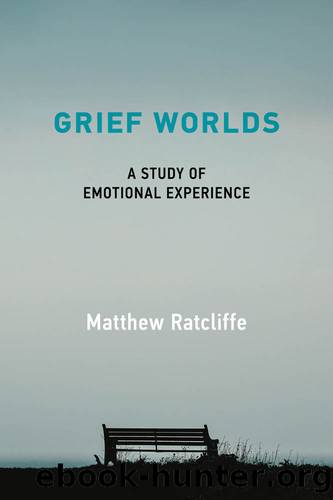Grief Worlds by Matthew Ratcliffe

Author:Matthew Ratcliffe
Language: eng
Format: epub
Tags: Emotional experience; emotion regulation; feeling; grief; interpersonal relations; loss; phenomenology; possibility; world-experience; Bereavement hallucinations; sensed-presence experiences; interpersonal experience; Complicated grief; depression; resilience; grief; Continuing bonds; object of grief; possibilities
Publisher: The MIT Press
This âimpressionâ is something that Lewis contrasts with a determinate representation derived from memory, imagination, and/or sensory perceptual experience. His description is consistent with what Merleau-Ponty would call another personâs style and its effect on oneâs sense of the possible. This need not be limited to a particular location, project, or pastime. A relationship with another person, living or dead, can pervade all aspects of oneâs life. And so, as Lewis ceases to worry about imposing a false memory and replacing his wife with his image of her, âshe seems to meet me everywhere,â not as an apparition with determinate properties, occupying a particular place, but as âa sort of unobtrusive but massive sense that she is, just as much as ever, a fact to be taken into accountâ (44).
As discussed earlier, some of those phenomena labeled as bereavement hallucinations may well be associated with âsearching behaviorâ (broadly construed). However, Lewisâs account points to something different. He finds his wife only after a certain kind of search is abandoned, one that involved, in his case, memory and imagination more so than perception. What he then discovers is not a nonveridical sensory image but a renewed connection. His description is reminiscent of the Myth of Orpheus and Eurydice. As Orpheus returns from the Underworld with Eurydice, he must walk ahead and not look back. Yet he increasingly doubts her presence and eventually turns in order to acquire the determinate sensory experience that he currently lacks. As he does so, her shadow returns to the Underworld, this time irrevocably. Lewisâs narrative runs the other way. The image of his wife eradicates what is distinctive about her and she is lost, returning only when he desists in his efforts to preserve her in memory. In both cases, the image not only fails to capture the other person; it is also what renders her inaccessible.
Interestingly, Lewis describes his grief as inseparable from his relationship with God. Loss of connection with his wife coincides with the loss of a faith that now strikes him as superficial and naive. Similarly, a renewed connection with his wife spells the rekindling of faith. The common theme here is inexhaustibility, something resisting all of oneâs efforts to conceptualize and somehow contain it: âImages of the Holy easily become holy imagesâsacrosanct. My idea of God is not a divine idea. It has to be shattered time after time. He shatters it Himself. He is the great iconoclastâ (55). In both cases, something is experienced as offering up possibilities that surpass oneâs own cognitions, affecting one in a dynamic, distinctive, living way.12
Lewisâs grief was notably solitary. However, the presence of the deceased need not be something that is experienced in isolation from other people. As Kathleen Higgins (2013, 175) observes, stories that we tell one another about the dead or that we co-construct with others are not always aimed at preserving specific, determinate properties in memory. They can also play a role in sustaining a sense of someoneâs spontaneity, that personâs
Download
This site does not store any files on its server. We only index and link to content provided by other sites. Please contact the content providers to delete copyright contents if any and email us, we'll remove relevant links or contents immediately.
| Deconstruction | Existentialism |
| Humanism | Phenomenology |
| Pragmatism | Rationalism |
| Structuralism | Transcendentalism |
| Utilitarianism |
The remains of the day by Kazuo Ishiguro(8822)
Tools of Titans by Timothy Ferriss(8218)
Giovanni's Room by James Baldwin(7192)
The Black Swan by Nassim Nicholas Taleb(7010)
Inner Engineering: A Yogi's Guide to Joy by Sadhguru(6725)
The Way of Zen by Alan W. Watts(6506)
Asking the Right Questions: A Guide to Critical Thinking by M. Neil Browne & Stuart M. Keeley(5636)
The Power of Now: A Guide to Spiritual Enlightenment by Eckhart Tolle(5605)
The Six Wives Of Henry VIII (WOMEN IN HISTORY) by Fraser Antonia(5396)
Astrophysics for People in a Hurry by Neil DeGrasse Tyson(5133)
Housekeeping by Marilynne Robinson(4347)
12 Rules for Life by Jordan B. Peterson(4250)
Double Down (Diary of a Wimpy Kid Book 11) by Jeff Kinney(4207)
The Ethical Slut by Janet W. Hardy(4173)
Skin in the Game by Nassim Nicholas Taleb(4162)
Ikigai by Héctor García & Francesc Miralles(4125)
The Art of Happiness by The Dalai Lama(4063)
Skin in the Game: Hidden Asymmetries in Daily Life by Nassim Nicholas Taleb(3929)
Walking by Henry David Thoreau(3894)
